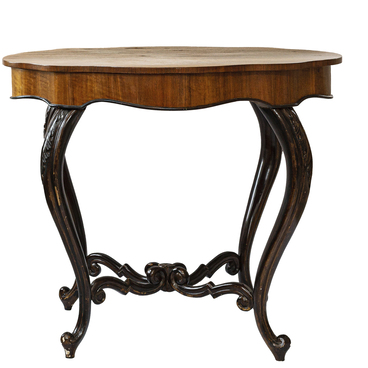The ombre table got its name from the card game “ombre”, which appeared in the 16th century in Spain. From there, this gambling hobby came to France and England and then became popular in Russia.
In Russia, cards appeared in the 16th century. Emperor Peter I tried to fight against gambling: he prohibited the army and navy to lose more than a ruble. Catherine II issued the edict forbidding the payment of card debts by bills of exchange or borrowing money to pay such debts. But both attempts proved futile: gambling remained one of the most popular pastimes in Russia.
The name “ombre” comes from the Spanish “hombre”, which means “man”. The game received this name because one man played against two men. Two partners were teaming up against a third, who held the stronger cards. He announced the game. For a game of ombre, 10 cards were left in each suit, removing eights, nines, and tens. The goal of the game was to get the most “bribes”. If the one who declared a game got more than four, he would take all the money he had staked, and if less, he would pay a fine.
Initially, card lovers played at ordinary tables, but cards slid on their surface and it was uncomfortable to play. Therefore, a table upholstered with cloth, with a symmetrical square tabletop and a minimum number of shelves and crossbars was made especially for the ombre. Linen, drape, or velvet was used to upholster the playing surface.
Ombre tables were usually handmade from expensive wood. They were painted or decorated with ivory, enamel, sometimes even precious stones. The ombre table showed the status and wealth of its master.
In the 18th century, folding tables appeared. During the day, there were vases of flowers put on them, and in the evening, when guests came, they were spread out to play so that the cloth-covered side became the outside. Then sliding tables came into fashion, the lid of which rotated at 90 degrees, and transformers, which, like origami, could be folded in all four corners.
Over time, the tables had small drawers for storing small items and playthings. Such model was called a “bureau”. On the tabletop, there could have been a chessboard painted. Stools in the same style began to be made as a set with tables.
In Russia, cards appeared in the 16th century. Emperor Peter I tried to fight against gambling: he prohibited the army and navy to lose more than a ruble. Catherine II issued the edict forbidding the payment of card debts by bills of exchange or borrowing money to pay such debts. But both attempts proved futile: gambling remained one of the most popular pastimes in Russia.
The name “ombre” comes from the Spanish “hombre”, which means “man”. The game received this name because one man played against two men. Two partners were teaming up against a third, who held the stronger cards. He announced the game. For a game of ombre, 10 cards were left in each suit, removing eights, nines, and tens. The goal of the game was to get the most “bribes”. If the one who declared a game got more than four, he would take all the money he had staked, and if less, he would pay a fine.
Initially, card lovers played at ordinary tables, but cards slid on their surface and it was uncomfortable to play. Therefore, a table upholstered with cloth, with a symmetrical square tabletop and a minimum number of shelves and crossbars was made especially for the ombre. Linen, drape, or velvet was used to upholster the playing surface.
Ombre tables were usually handmade from expensive wood. They were painted or decorated with ivory, enamel, sometimes even precious stones. The ombre table showed the status and wealth of its master.
In the 18th century, folding tables appeared. During the day, there were vases of flowers put on them, and in the evening, when guests came, they were spread out to play so that the cloth-covered side became the outside. Then sliding tables came into fashion, the lid of which rotated at 90 degrees, and transformers, which, like origami, could be folded in all four corners.
Over time, the tables had small drawers for storing small items and playthings. Such model was called a “bureau”. On the tabletop, there could have been a chessboard painted. Stools in the same style began to be made as a set with tables.



